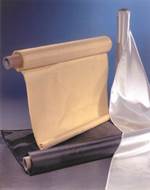Fiber Reinforcement Types
Because small-diameter filaments are extremely fragile, they are supplied in bundles. The terminology for identifying these bundles varies, based on the type of fiber. Glass and aramid fiber bundles are called strands, rovings or yarns. In current usage, a “strand” is a collection of continuous filaments and a
Share
Because small-diameter filaments are extremely fragile, they are supplied in bundles. The terminology for identifying these bundles varies, based on the type of fiber. Glass and aramid fiber bundles are called strands, rovings or yarns. In current usage, a “strand” is a collection of continuous filaments and a “roving” is a collection of untwisted strands. “Yarns” are collections of filaments or strands that are twisted together (regardless of fiber type). In carbon fiber parlance, “tows” are untwisted fiber bundles.
Rovings and tows are the basic fiber forms which can be used to produce a wide variety of reinforcing materials including mats, woven fabrics, knitted fabrics, tubular braids, etc. Mats are non-woven fabrics that come in two forms: chopped and continuous strand. Chopped strand mat contains randomly distributed fibers cut to lengths typically ranging from 1.5 to 2.5 inches/38 to 64 mm, held together with a chemical binder. They provide a low-cost reinforcement for some processes. In contrast, continuous strand mat is formed by swirling continuous fiber onto a moving belt; fibers are held in place with a chemical binder. Due to its higher strength, continuous strand mat is primarily used in molding and pultrusion processes, producing structural elements for offshore applications. Extremely lightweight mats, called veils, are often used as a surfacing material. Their very open fiber arrangement is designed to create a resin-rich surface for enhanced durability, toughness, chemical resistance or appearance. Surfacing veils are used to provide a corrosion resistant inner surface on some types of piping as well.
Bidirectional woven fabrics provide good strength in the 0°/90° directions and allow fast composite fabrication. However, woven goods have lower tensile strength because fibers are crimped as they pass over and under one another in the fabric. Under tensile loading, the crimped fibers tend to straighten out, creating stress in the part.
Hybrid fabrics are often produced to take advantage of the properties of two or more fiber types. For example, carbon fiber provides high strength and stiffness in the longitudinal direction while Eglass in the transverse direction gives adequate strength for many applications.
Crimping is avoided altogether with stitched non-woven multiaxial reinforcements. Multiple layers of unidirectional yarns or roving are placed on top of each other, at varying angles (usually a combination of 0°, 90°, +45°, -45°, and so on), and the assemblage is loosely through-stitched to hold the layers in alignment during processing. Finished laminate strength significantly improves with multiaxials in place of woven fabrics.
Braided materials, while typically more expensive because of the cost of the braiding process, generally offer greater strength per unit of fabric weight. This is because the yarns or rovings are continuously woven on the bias and have at least one axial yarn that is not crimped in the process. The arrangement of yarns, the directions of which can be customized, facilitates highly efficient load distribution throughout the braid.
Related Content
-
Plant tour: Albany Engineered Composites, Rochester, N.H., U.S.
Efficient, high-quality, well-controlled composites manufacturing at volume is the mantra for this 3D weaving specialist.
-
Composite resins price change report
CW’s running summary of resin price change announcements from major material suppliers that serve the composites manufacturing industry.
-
PEEK vs. PEKK vs. PAEK and continuous compression molding
Suppliers of thermoplastics and carbon fiber chime in regarding PEEK vs. PEKK, and now PAEK, as well as in-situ consolidation — the supply chain for thermoplastic tape composites continues to evolve.










.jpg;maxWidth=300;quality=90)


